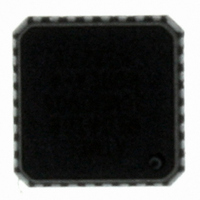ATMEGA168-20MU Atmel, ATMEGA168-20MU Datasheet - Page 268

ATMEGA168-20MU
Manufacturer Part Number
ATMEGA168-20MU
Description
IC AVR MCU 16K 20MHZ 32-QFN
Manufacturer
Atmel
Series
AVR® ATmegar
Datasheets
1.ATAVRTS2080B.pdf
(378 pages)
2.ATMEGA48-20AU.pdf
(35 pages)
3.ATMEGA88-20MU.pdf
(33 pages)
Specifications of ATMEGA168-20MU
Core Processor
AVR
Core Size
8-Bit
Speed
20MHz
Connectivity
I²C, SPI, UART/USART
Peripherals
Brown-out Detect/Reset, POR, PWM, WDT
Number Of I /o
23
Program Memory Size
16KB (8K x 16)
Program Memory Type
FLASH
Eeprom Size
512 x 8
Ram Size
1K x 8
Voltage - Supply (vcc/vdd)
2.7 V ~ 5.5 V
Data Converters
A/D 8x10b
Oscillator Type
Internal
Operating Temperature
-40°C ~ 85°C
Package / Case
32-VQFN Exposed Pad, 32-HVQFN, 32-SQFN, 32-DHVQFN
Processor Series
ATMEGA16x
Core
AVR8
Data Bus Width
8 bit
Data Ram Size
1 KB
Interface Type
2-Wire, SPI, USART, Serial
Maximum Clock Frequency
20 MHz
Number Of Programmable I/os
23
Number Of Timers
3
Operating Supply Voltage
2.7 V to 5.5 V
Maximum Operating Temperature
+ 85 C
Mounting Style
SMD/SMT
3rd Party Development Tools
EWAVR, EWAVR-BL
Development Tools By Supplier
ATAVRDRAGON, ATSTK500, ATSTK600, ATAVRISP2, ATAVRONEKIT
Minimum Operating Temperature
- 40 C
On-chip Adc
10 bit, 8 Channel
A/d Inputs
8-Channel, 10-Bit
Cpu Speed
20 MIPS
Eeprom Memory
512 Bytes
Input Output
23
Interface
I2C/SPI/UART/USART
Memory Type
Flash
Number Of Bits
8
Package Type
32-pin MLF
Programmable Memory
16K Bytes
Timers
2-8-bit, 1-16-bit
Voltage, Range
4.5-5.5 V
Cpu Family
ATmega
Device Core
AVR
Device Core Size
8b
Frequency (max)
20MHz
Total Internal Ram Size
1KB
# I/os (max)
23
Number Of Timers - General Purpose
3
Operating Supply Voltage (typ)
3.3/5V
Operating Supply Voltage (max)
5.5V
Operating Supply Voltage (min)
2.7V
Instruction Set Architecture
RISC
Operating Temp Range
-40C to 85C
Operating Temperature Classification
Industrial
Mounting
Surface Mount
Pin Count
32
Controller Family/series
AVR MEGA
No. Of I/o's
23
Eeprom Memory Size
512Byte
Ram Memory Size
1KB
No. Of Timers
3
Rohs Compliant
Yes
Package
32MLF EP
Family Name
ATmega
Maximum Speed
20 MHz
For Use With
ATSTK600-TQFP32 - STK600 SOCKET/ADAPTER 32-TQFPATSTK600-DIP40 - STK600 SOCKET/ADAPTER 40-PDIP770-1007 - ISP 4PORT ATMEL AVR MCU SPI/JTAGATAVRDRAGON - KIT DRAGON 32KB FLASH MEM AVRATAVRISP2 - PROGRAMMER AVR IN SYSTEMATJTAGICE2 - AVR ON-CHIP D-BUG SYSTEM
Lead Free Status / RoHS Status
Lead free / RoHS Compliant
Available stocks
Company
Part Number
Manufacturer
Quantity
Price
- Current page: 268 of 378
- Download datasheet (8Mb)
26. Boot Loader Support – Read-While-Write Self-Programming, ATmega88 and
26.1
26.2
26.3
26.3.1
26.3.2
268
ATmega168
Features
Overview
Application and Boot Loader Flash Sections
ATmega48/88/168
Application Section
BLS – Boot Loader Section
•
•
•
•
•
•
•
Note:
In ATmega88 and ATmega168, the Boot Loader Support provides a real Read-While-Write Self-
Programming mechanism for downloading and uploading program code by the MCU itself. This
feature allows flexible application software updates controlled by the MCU using a Flash-resi-
dent Boot Loader program. The Boot Loader program can use any available data interface and
associated protocol to read code and write (program) that code into the Flash memory, or read
the code from the program memory. The program code within the Boot Loader section has the
capability to write into the entire Flash, including the Boot Loader memory. The Boot Loader can
thus even modify itself, and it can also erase itself from the code if the feature is not needed any-
more. The size of the Boot Loader memory is configurable with fuses and the Boot Loader has
two separate sets of Boot Lock bits which can be set independently. This gives the user a
unique flexibility to select different levels of protection.
The Flash memory is organized in two main sections, the Application section and the Boot
Loader section (see
BOOTSZ Fuses as shown in
have different level of protection since they have different sets of Lock bits.
The Application section is the section of the Flash that is used for storing the application code.
The protection level for the Application section can be selected by the application Boot Lock bits
(Boot Lock bits 0), see
Boot Loader code since the SPM instruction is disabled when executed from the Application
section.
While the Application section is used for storing the application code, the The Boot Loader soft-
ware must be located in the BLS since the SPM instruction can initiate a programming when
executing from the BLS only. The SPM instruction can access the entire Flash, including the
BLS itself. The protection level for the Boot Loader section can be selected by the Boot Loader
Lock bits (Boot Lock bits 1), see
Read-While-Write Self-Programming
Flexible Boot Memory Size
High Security (Separate Boot Lock Bits for a Flexible Protection)
Separate Fuse to Select Reset Vector
Optimized Page
Code Efficient Algorithm
Efficient Read-Modify-Write Support
1. A page is a section in the Flash consisting of several bytes (see
during programming. The page organization does not affect normal operation.
(1)
Size
Figure
Table 26-2 on page
Table 26-6 on page 280
26-2). The size of the different sections is configured by the
Table 26-3 on page
272. The Application section can never store any
272.
and
Figure
26-2. These two sections can
Table 27-9 on page
2545S–AVR–07/10
288) used
Related parts for ATMEGA168-20MU
Image
Part Number
Description
Manufacturer
Datasheet
Request
R

Part Number:
Description:
Manufacturer:
Atmel Corporation
Datasheet:

Part Number:
Description:
Manufacturer:
Atmel Corporation
Datasheet:

Part Number:
Description:
Manufacturer:
ATMEL Corporation
Datasheet:

Part Number:
Description:
IC AVR MCU 16K 20MHZ 32TQFP
Manufacturer:
Atmel
Datasheet:

Part Number:
Description:
IC AVR MCU 16K 20MHZ 28DIP
Manufacturer:
Atmel
Datasheet:

Part Number:
Description:
MCU AVR 16K FLASH 15MHZ 32-TQFP
Manufacturer:
Atmel
Datasheet:

Part Number:
Description:
MCU AVR 16K FLASH 15MHZ 32-QFN
Manufacturer:
Atmel
Datasheet:

Part Number:
Description:
IC AVR MCU 16K 20MHZ 32TQFP
Manufacturer:
Atmel
Datasheet:

Part Number:
Description:
MCU AVR 16KB FLASH 20MHZ 32QFN
Manufacturer:
Atmel
Datasheet:

Part Number:
Description:
MCU AVR 16KB FLASH 20MHZ 32TQFP
Manufacturer:
Atmel
Datasheet:

Part Number:
Description:
IC MCU AVR 16K FLASH 32-QFN
Manufacturer:
Atmel
Datasheet:











